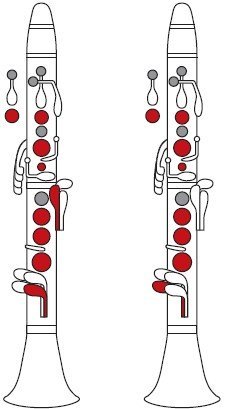Introduction to the G Dorian Scale
The G Dorian scale holds a special place in clarinet music. Imagine a smooth, jazzy sound blended with classical overtones, all wrapped up in a scale with a rich history. That's the essence of the G Dorian scale.

Clarinet Fingering Charts are always FREE at MartinFreres.net!
Please enter your email address below so we can email you a FREE PDF file with the music sheet and correct clarinet fingerings for each note.
What is the G Dorian Scale?
The G Dorian scale is like a minor scale with an extra twist – its raised sixth note adds brightness and a touch of mystery. This unique characteristic makes it a favorite among composers and improvisers, especially in genres that emphasize emotion and expression. Musicians across various backgrounds have embraced this scale to create captivating solos and ensembles, with its influence spanning numerous musical traditions.
Historical Context of the G Dorian Scale
The G Dorian scale's roots can be traced back to medieval and Renaissance times when modal music was prevalent. Before the major and minor scale system became dominant, modes like the Dorian scale were widely popular. Musicians loved it for its versatility and emotional range. This modality allowed for exploration beyond the usual major and minor keys, offering a diverse sound palette. Remarkably, this scale continues to be relevant and inspiring in contemporary music.
| Era | Significance of G Dorian Scale |
|---|---|
| Medieval & Renaissance | Widely used in modal music |
| Classical Period | Less prominent due to major/minor system |
| Modern Era | Revival in jazz and contemporary classical music |
The Clarinet and G Dorian Scale
The clarinet particularly benefits from the G Dorian scale due to its rich, warm sound. The scale's smooth transitions and melodic possibilities complement the instrument's tonal qualities perfectly. When playing in G Dorian, clarinetists can explore a wide range of expressive possibilities. Renowned composers like Bach and Gershwin have incorporated modes into their works, demonstrating how the G Dorian scale can enhance a piece's emotional depth.
Performance Aspects of G Dorian
Imagine being on stage, the lights dimmed, as you begin a G Dorian solo. The audience is captivated, feeling every note and nuance. This scale offers a unique magic, allowing for improvisations that flow between swinging rhythms and beautiful melodies. It's particularly effective in jazz and jazz-influenced pieces, providing a perfect tool for musicians to create unforgettable performances.
Educational Value of the G Dorian Scale
The G Dorian scale plays a significant role in music education, especially for budding clarinetists. Learning this scale helps students grasp modal harmony and develop improvisation skills. It offers a perfect balance of structure and creativity, laying the groundwork for young musicians to explore various musical styles that incorporate this scale.
Versatility of G Dorian
As you explore music featuring the G Dorian scale, you'll find it in both traditional classical works and modern jazz compositions. Its versatility allows it to transcend genre boundaries. From intricate clarinet concertos to soulful jazz standards, the G Dorian scale showcases its adaptability, much like a musical chameleon.
Mastering the G Dorian Scale
Mastering the G Dorian scale involves more than just technical proficiency; it's about feeling the music and bringing the notes to life. Whether you're a beginner or an experienced player, understanding how to express the subtleties of this scale can significantly enhance your performance. Think of improvisation with G Dorian as a musical conversation, where you're exchanging ideas through melodies and harmonies.
Artistic Growth Through G Dorian
For clarinetists delving deeper into their craft, understanding scales like G Dorian is crucial for artistic development. Exploring this scale goes beyond learning technical aspects; it opens up a world of musicality and style. It enriches a clarinetist's artistic expression, transforming ordinary pieces into vivid musical narratives.
Conclusion
Music is fundamentally about expression, connection, and exploration. The G Dorian scale represents a significant milestone in musical history, inviting clarinetists of all eras to tap into its rich potential. From its traditional roots to its use in contemporary jam sessions, this scale is more than just a series of notes – it's an integral part of the clarinet's evolving story.
Table of Contents
- Introduction to the G Dorian Scale
- What is the G Dorian Scale?
- Historical Context of the G Dorian Scale
- The Clarinet and G Dorian Scale
- Performance Aspects of G Dorian
- Educational Value of the G Dorian Scale
- Versatility of G Dorian
- Mastering the G Dorian Scale
- Artistic Growth Through G Dorian
- Conclusion








